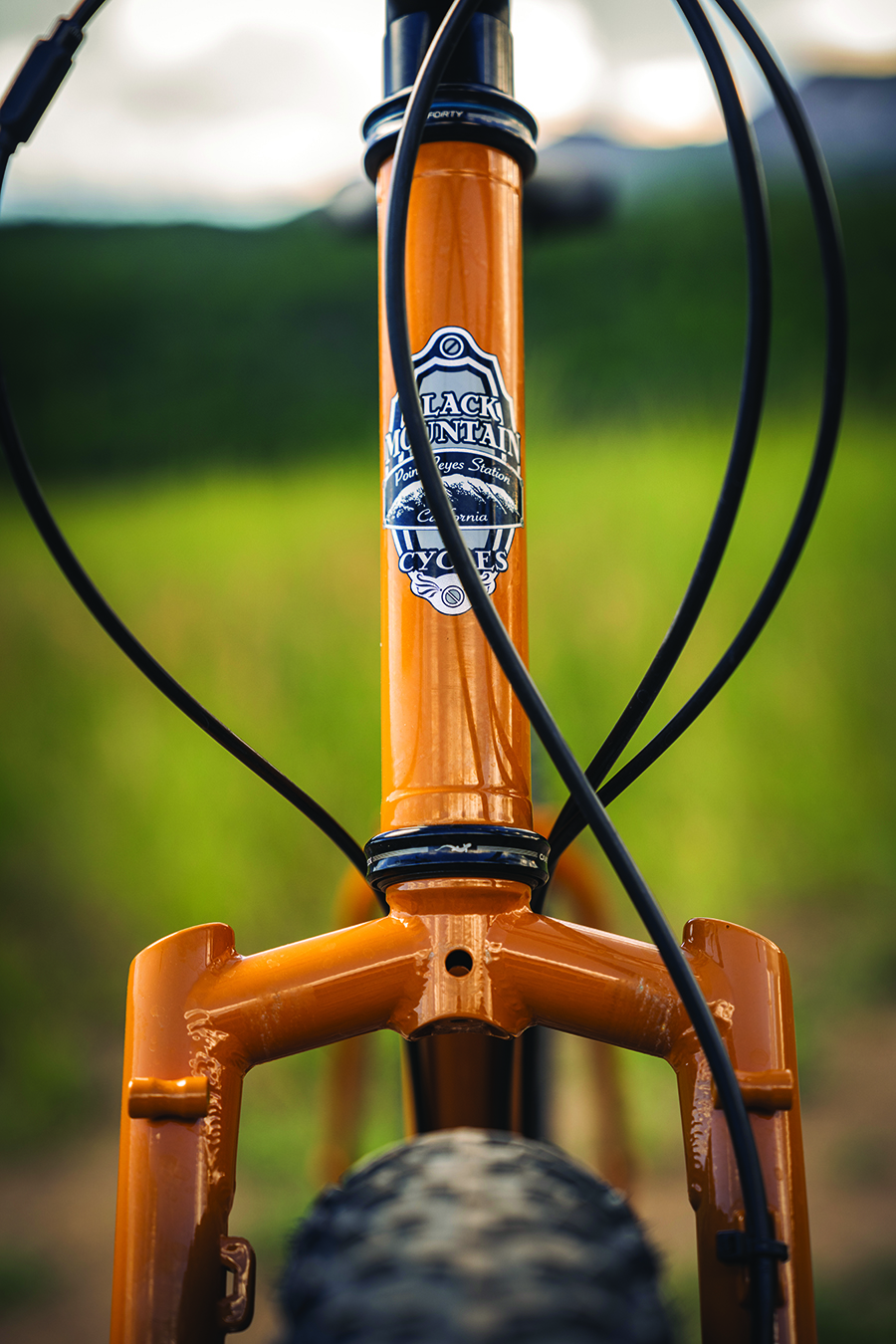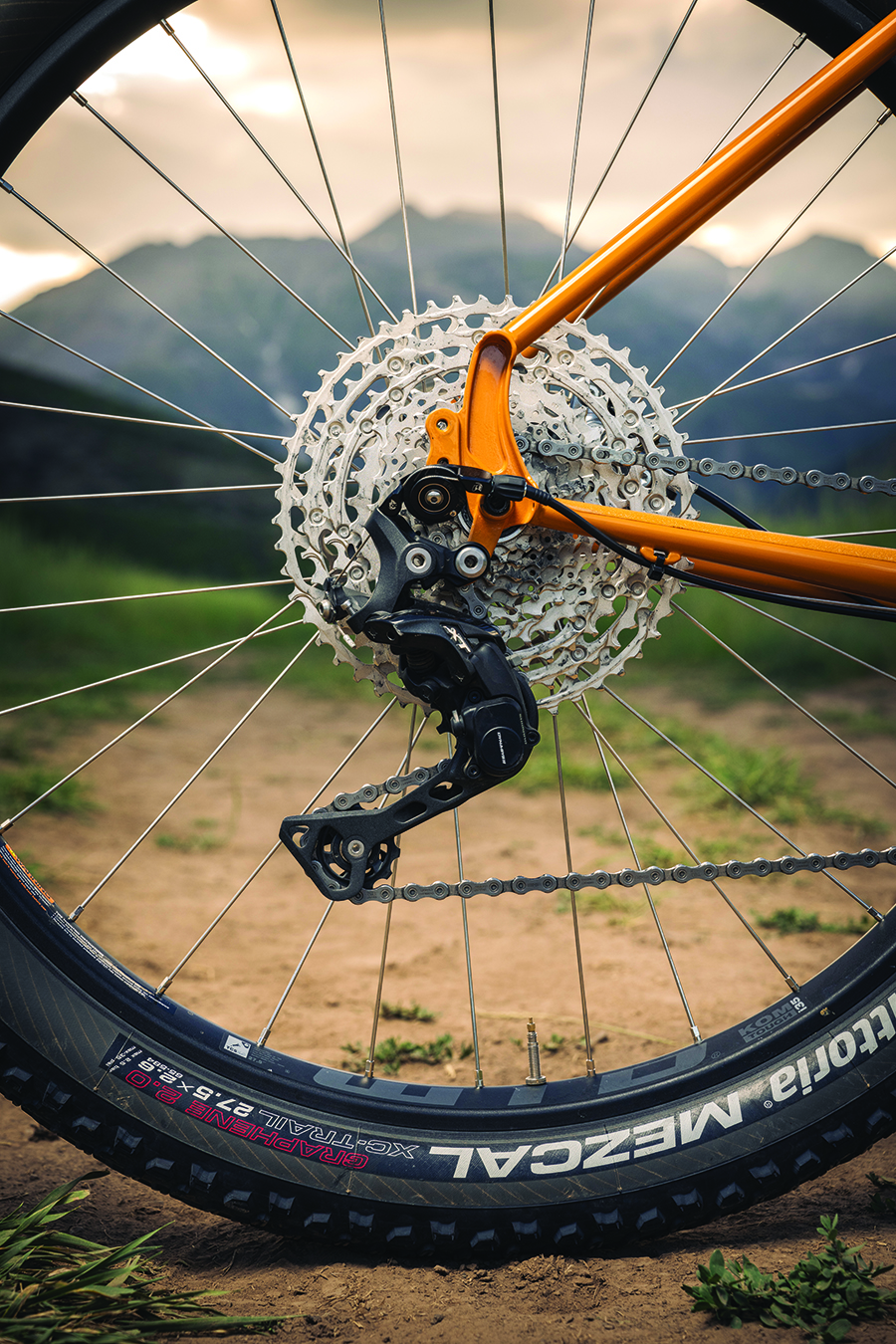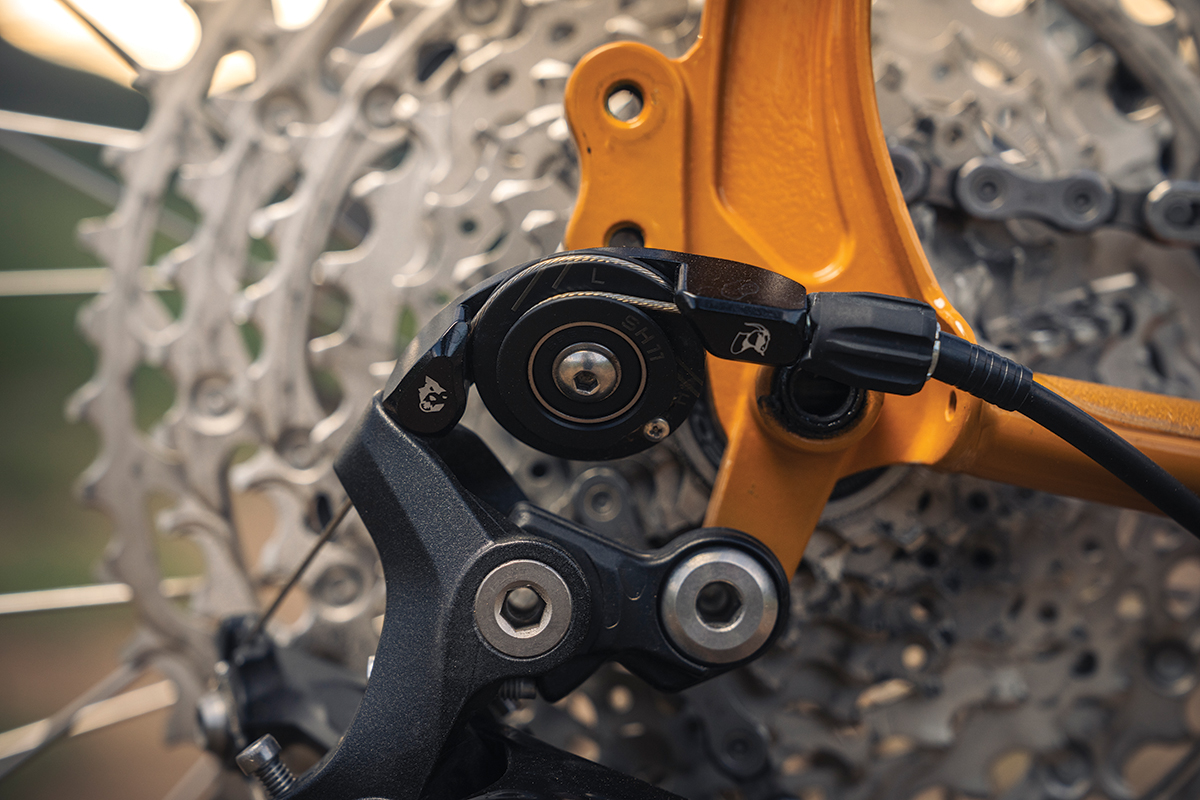Road Test: Black Mountain Cycles La Cabra
This article first appeared in the January/February 2024 issue of Adventure Cyclist magazine.
It’s no secret that I’m a fan of Black Mountain Cycles: they’re simple and affordable steel bicycles designed by owner Mike Varley and produced in small batches overseas. After reviewing an MCD way back in the July 2019 issue, I purchased a Road+ frame that I turned into my beloved do-anything fender/basket bike. Since then, both the MCD and the Road+ have been discontinued and replaced by the Mod Zero. In addition to the Mod Zero and the rim brake Monster Cross, Black Mountain Cycles also offers La Cabra, “the goat.”
La Cabra is a dropbar mountain bike that blends the best aspects of old-school design elements with a few modern touches. The 4130 chromoly tubing is on the skinny side, the head tube is straight 1 1/8in., and the brake mounts are international standard (IS), all of which seem positively vintage these days. On the other hand, the frame has internal routing for a dropper seatpost, Boost hub spacing and thru-axles for modern wheels, and is designed around a wide-range 1x drivetrain (though it can accommodate 2x). To my eye, La Cabra looks like the original Salsa Fargo updated for the modern world.
The fork is non-suspension-corrected and is a work of functional art with a segmented crown, hooded dropouts, and all the braze-ons you could possibly need for fenders, racks, cargo cages, and dynamo lights. The frame has rear rack and fender mounts, triple mounts on the underside of the down tube, and room for two bottles inside the triangle on the three smaller sizes and three bottles on the two largest sizes. La Cabra can fit 27.5in. tires up to 2.8in. wide or 29in. tires up to 2.3in. It was designed around dropbars, but you can fit a flat handlebar if that’s more your speed.

Varley, who also runs the Black Mountain Cycles shop in Point Reyes Station, California, offers La Cabra as a frameset for $1,195 or as a complete in a few different builds. My test bike arrived in the Shimano kit with 27.5in. wheels, 2.6in. Vittoria Mezcal tires, and a dropper post. The drivetrain consisted of Shimano GRX levers mated to a Wolf Tooth Tanpan adapter in order to shift an XT derailer across an 11-speed Deore 11–51T cassette, with a 30T chainring on an XT crank. It’s a bit of a mishmash and doesn’t make for the crispest shifting, but it works well enough and has a nice, broad gear range for loaded riding. With the 1x GRX shifters, the left lever actuates the 125mm KS Lev Integra dropper post, which is the most effective and ergonomic solution I’ve come across yet for mating a dropper to a dropbar setup.
As with all his complete builds, Varley assembled the wheels himself, lacing DT Swiss 350 hubs to WTB’s KOM Tough i35 rims. It’s a bomber wheelset that proved to be flawless during my test period. Mounted tubeless to the rims were Vittoria’s Mezcal tires. It was my first experience with this Italian tire brand, and the Mezcals were fast-rolling and plenty grippy on trails. Riding the bike hard with pressure in the mid-teens, the tires suffered no punctures or tears. I’ve now got the Mezcals on my list of great tires for bikepacking.
For touchpoints, Varley installed a Salsa Cowchipper bar and a WTB Volt saddle. I swapped out the Volt for my preferred Brooks Cambium C17, and while I generally prefer bars with less flare than the Cowchipper, I found it suited the bike quite well. I also liked the 460mm width — plenty wide enough to fit a big handlebar bag and provide leverage for trail riding without being so wide as to feel inefficient when putting down the miles.

La Cabra is part of a resurgence in dropbar mountain bikes in recent years, joining the likes of the Tumbleweed Stargazer and the Surly Grappler, among others. But whereas many of those bikes take cues from the evolution of mountain bike geometry, with slacker head angles and longer reaches, the geo of La Cabra seems downright ordinary, almost old-fashioned. But don’t let the numbers fool you; La Cabra is a mountain bike through and through.
My first few rides with La Cabra took place on local singletrack trails in the foothills, with steep, punchy climbs, fast descents, and the usual loose-over-hard trail surface that leaves you wanting for traction. I ride these trails with gravel and mountain bikes alike, but I’ll approach my ride differently depending on the rig — if I’m on a dropbar bike, I’m mostly staying in the saddle and trying to keep it rubber-side down. Such was my initial approach on La Cabra, the curly bar misleading me into thinking it would ride more like a gravel bike.
The first indication of my wrong-headedness came when the trail pitched up. I spend most of my time on the hoods when riding dropbar bikes, but the stack height is so high on La Cabra that as soon as the grade went up, I felt much more comfortable with my hands in the drops. Now that I was in the hooks climbing a steep pitch, it felt natural to stand out of the saddle and give it a little gas, and that’s when it hit me: this thing wants to go.
What struck me years ago about the MCD was just how lively it was, and now it was clear that Varley had managed to instill La Cabra with that same ephemeral quality.
At the top of the climb, I turned around, lowered the dropper post, and proceeded to confirm that, yes, La Cabra is a dang mountain bike. I had never ridden a dropbar bike so fast on singletrack, nor while hooting and hollering and … wait for it … hitting jumps(!). Granted they were little baby jumps, which are the only kind of jumps I do anyway, but my point stands: what I thought was going to be a beast-of-burden type of bikepacking rig, intended for churning through the miles on some distant dirt road, turned out to be, in fact, one of the funnest mountain bikes I’ve ever dropped my heels on. I was leaning into corners, sprinting out of the saddle, and generally riding La Cabra like a wild dog runs down a jackrabbit.

And yet, La Cabra is also a fine bikepacking rig. Last summer, I loaded it up for a three-day loop on dirt roads in Nevada (see “The Middle of Nowhere is in Eastern Nevada,” November/December 2023), and it was the perfect companion for a long weekend of self-supported riding on variable desert terrain. With a Rawland Rando rack supporting a Road Runner Jumbo Jammer bag in the front, an Oveja Negra framebag in the middle, a Tumbleweed T-Rack in the rear, and Outer Shell’s Pico Panniers on the fork, I was able to carry everything I needed to stay fed, hydrated, and sheltered in the high desert. I didn’t pack like a minimalist; I had a full tent, a folding chair, and lots of food — even when weighed down with extra water, La Cabra never felt slow or ungainly. It helped that its starting weight was a mere 27.6 pounds, which I consider pretty darn good for a steel bike with alloy wheels and components. And with that high stack, it made for a very comfortable place to pedal out the miles all day long.
I’m an unapologetic 29er fanboy, but I was curious about the 27.5 x 2.6in. setup, and I’m glad that it was included on my test bike. The smaller wheels spun up quickly and felt a little more eager to be whipped around corners compared to 29in., and I never felt like I needed the taller wheels for better rollover. Similarly, the fat 2.6in. rubber felt great on singletrack and worked a treat on the wide variety of road surfaces I encountered in Nevada. The big tires rolled right over rocks and potholes, and I was able to stay afloat on sandy tracks for longer than my riding partner, who was on 2.3in. tires, although I still managed to spin out in the really deep stuff. It’s not a fat bike, after all. If I were planning to ride a route that I knew was composed of smooth dirt roads and I intended to prioritize speed and efficiency, I would opt for 29in. wheels, but that’s the beauty of La Cabra: you could have a couple of wheelsets and swap between them depending on conditions.
I don’t have much to report from the complaint department. My test bike arrived with a rear brake that needed a bleed, which I quickly had done at my local shop, but I guess it didn’t take. During the Nevada trip, I noticed the issue get worse and worse; I would have to pump the lever several times to get the rear brake to work. Also, on rough, high-speed descents with the bike fully loaded, I noticed some weird handling characteristics, as if the bike were flexing too much under me and wandering a little. It was disconcerting, but it went away after I checked some speed. I confirmed with Varley that La Cabra is not an expedition bike; he designed it to ride best with “minimal to modest” loads, and really heavy loads might overwhelm it. So this probably isn’t the rig to carry your collection of cast-iron pans.
When I first saw pictures of Varley’s second run of La Cabra frames, I initially had misgivings about the color, Peanut Butter (Pantone 7511 if you’re curious). It grew on me over time, and when I finally saw it in person, I found I liked it quite a bit. While riding La Cabra, I noticed a nice bonus to the Peanut Butter paint: it hides dirt and mud very well, which makes it a great choice for a bikepacking bike!
My complete test bike came to the tune of $4,235, which is kinda pricey for a rigid steel bike, but it’s a needs-nothing build that includes high-quality wheels laced up by the man himself. If I were buying one myself, I’m not sure I would change anything from the test build aside from swapping in a 32T chainring instead of the 30T (saddles don’t really count as they are so personal), but that’s a quibble.
In addition to the Shimano complete, Varley also offers a couple of SRAM dropbar builds with hydro or mechanical disc brakes, as well as a couple of flat bar builds that are quite a bit more affordable than the dropbar offerings. (Note that any complete build from Black Mountain Cycles includes handbuilt wheels.) The frameset price of $1,195 is on the higher end of frames produced in Taiwan, but I think it’s a fair number, and if you already have parts on-hand, buying the frameset can save you some coin in the long run.
I’ve reviewed a lot of great bikes over my years at Adventure Cyclist magazine, but only a few of them have really stood out as something special. One of them was that MCD, and La Cabra is another. It’s a perfect example of how a great bike is alchemy. No single factor explains it; instead, I can only point to the compliant frame, the magic of handbuilt wheels, and the geometry chosen by someone who has been designing bikes for decades. It all comes together to produce a bicycle that simply feels alive.
Black Mountain Cycles La Cabra
General
Best uses: Mountain biking, bikepacking, gravel riding
Price: $4,235 complete, as tested (frameset $1,195)
Weight: 27.6 lbs. (without pedals)
Available sizes: 15in., 16in., 18in., 20in., 22in.
Size tested: 18in.
Contact: blackmtncycles.com
Components
Frame: 4130 chromoly steel, rack and fender mounts, triple mounts on underside of down tube, two bottle mounts in front triangle
Fork: 4130 chromoly steel, rack and fender mounts, triple mounts
Tires: Vittoria Mezcal 27.5 x 2.6in., tubeless
Shifters: Shimano GRX 1x
Cassette: Shimano Deore 11spd, 11–51T
Brakes: Shimano RS785 hydraulic disc
Notable Geometry
Head tube angle: 70.5°
Reach: 385mm
Stack: 632mm
Seat tube length: 460mm
BB drop: 70mm
Head tube length: 175mm
Standover: 799mm

